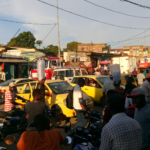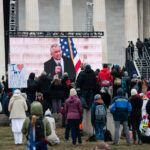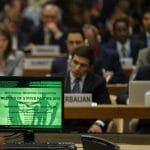Can the U.S. lead the way on dual-use education?
By Malcolm Dando | June 16, 2009
Since the Second Review Conference of the Biological and Toxin Weapons Convention (BWC) in 1986, States Parties have made suggestions for how to educate life scientists about and raise awareness of the dual-use implications of their benignly intended work. But little truly has been done to engage scientists on the subject. Last December, at the convention’s intersessional meeting, I couldn’t help but be skeptical (See my October 2008 column, “Acting to Educate Life Scientists.”) about the States Parties’ agreement on a set of proposals that would address a lack of awareness of dual-use technologies among life scientists. But it was a rather nice surprise to see the U.S. National Science Advisory Board for Biosecurity (NSABB) publish its “Strategic Plan for Outreach and Education on Dual Use Research Issues” that same month. Perhaps the tide is changing.
Of course, it’s not simply that there is another report; it’s that the report is solid and provides a framework for implementing dual-use education. In fact, if the Obama administration reviews this report and chooses to act upon it, it might be just the lead other countries are waiting to follow.
Although promoting education and awareness at the national and international level is important, it will take time for governments to develop the necessary laws and organizations to make large-scale, international education possible.”
For those who aren’t aware, I have spent the last few years working with colleagues at the Bradford Disarmament Research Center, the National Defense Medical College of Japan, and the Landau Network-Centro Volta in Italy to quantify life scientists’ awareness of dual-use issues (it happens to be quite low) and to develop an educational resource that would allow lecturers to incorporate these issues into their university-level bioethics or biosafety courses. The NSABB report reinforced some of what we’re already doing and how we’re already thinking–for example, we agree that “[s]ince researchers bear the primary responsibility for the integrity of their work [. . .] awareness of dual-use research issues by the scientific community would be fundamental to any successful system of oversight.” It also provided food for thought and new guidance on how to communicate with scientists on dual-use challenges.
Among its key points, the report emphasizes the need for a dialogue with the scientific community around dual-use issues rather than a one-way declaration of rules and regulations by a government or other stakeholders. The report suggests, “Outreach should entail both efforts to educate and provide information to the research community, as well as to ensure avenues of input into the federal policy-making process.” This is a helpful recommendation, yet regarding disciplines–such as synthetic biology–that are in periods of extremely rapid scientific and technological change, scientists alone have the necessary knowledge to advise on potential risks and adequate remedies.
Secondly, the NSABB report calls for an international, cooperative effort to raise awareness and educate scientists on dual-use challenges. A variety of processes are underway globally to deal with awareness-raising and education in the life sciences community. But what is happening in one country is not necessarily known in another–regardless of how close countries are politically or geographically. Enhanced international cooperation would speed up the evolution of best practices in dual-use education.
Thirdly, the NSABB report lays out a three-pronged strategy for effective outreach: target audiences, messaging, and vehicles for information distribution. It’s a straightforward but involved strategy. For example, an audience should be “assessed as to their level of understanding of the issue, since this will guide educational strategies.” Subsequently, messages should be tailored to an audience’s interests and needs. Finally, an assessment must be made of how to present the messages to the target audience in the most effective way. In the aforementioned educational module we’re developing, based on our audience assessment, we present dual-use research in a wide conceptual context. Our module begins with 20th century state-level offensive biological weapons programs, moves to the international prohibition regime put in place to counter such programs, introduces bioethics and the problem of dual-use research, then talks about the national implementations of the BWC and where it may lead in the future. We plan to deliver this module online by the end of the year for anyone to use.
Fourthly, the report doesn’t just set out its recommendations, it also reviews some of the key conceptual thinking that led to its conclusions. This is a particularly valuable attribute of the NSABB’s strategic plan. In our work on raising awareness and education, we have struggled to think through some of these issues–for example, how to begin the conversation on dual use and how to format our educational tool. After some debate we concluded that the best way to introduce the issue of dual-use was through a consideration of bioethics, particularly since life scientists have some familiarity with bioethics in other contexts even if the present literature on “dual-use bioethics” is not extensive (See my April 2009 column, “Bioethicists Enter the Dual-use Debate.”) We also decided that our tool should be in the model of an open-source educational module resource rather than a prescribed program that had to be followed in a set way. This will allow life scientists to decide which specific parts of the comprehensive module to incorporate into their already-crowded curricula. The NSABB report’s intellectual exploration will certainly inform our further work and will likely be helpful to others as well.
The bottom line is that educating life scientists about dual-use challenges is necessary and possible. And although promoting education and awareness at the national and international level is important, it will take time for governments to develop the necessary laws and organizations to make large-scale, international education possible. I hope that while we wait, the NSABB strategic plan will be read widely and will help move nongovernmental initiatives forward. The Obama administration’s response to the report is especially important. U.S. action may prove to be the impetus the international community has been waiting for to make a move on widespread dual-use education.
Together, we make the world safer.
The Bulletin elevates expert voices above the noise. But as an independent nonprofit organization, our operations depend on the support of readers like you. Help us continue to deliver quality journalism that holds leaders accountable. Your support of our work at any level is important. In return, we promise our coverage will be understandable, influential, vigilant, solution-oriented, and fair-minded. Together we can make a difference.
Topics: Biosecurity, Columnists















